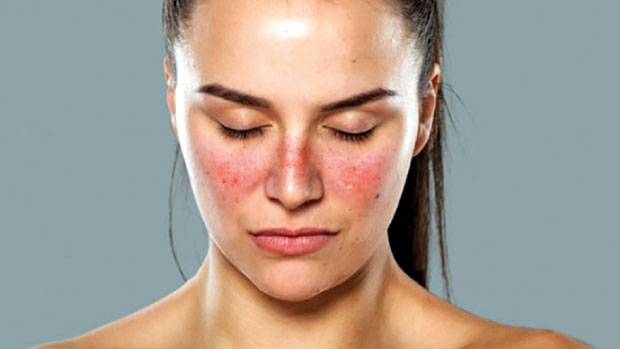16 Feb 2018 - {{hitsCtrl.values.hits}}

Lupus in Latin is a name given for wolf. Lupus in medical terms is devoted to a condition that mostly affects females. Starting from skin rashes, hair loss, joint pain and mouth ulcers, Lupus could critically affect even the kidneys and the brain in some. So here is a short article on what lupus is and how to overcome this dreaded disease of the young.
Definition 
Lupus, also known as SLE (Systemic Lupus Erythematosus), is a connective tissue disease that affects women nine times more than men. So then comes the question, what connective tissues are? As the name implies, connective tissue provides the human body with a connection between organs. This is the ‘Layer’ or ‘Substrate’ that ‘Fills in the gaps’ in our body. Not just filling in, connective tissue suspends the organs, even the tiny blood vessels, nerves and skin. The tissue is responsible for nourishing body components. So imagine a situation where the connective tissue does not do its job in ‘Connecting’? Then its neighbours which are all vital organs will receive no support nor communication. If I oversimplify things, what affects the connective tissue can affect almost any organ in our body. Connective tissue damage is caused by tiny particles of proteins called antibodies. These antibodies are made by the patient against the patient.
So why was it called Lupus in the first place? During medieval times (5th to 15th century) women who had Lupus were considered evil. This mythical belief was based on the fact that patients had a very prominent rash over the face which resembled the face of a wolf, had epilepsy and that they acted strangely because of the psychiatric conditions that were associated with Lupus.
How do I feel it?
Lupus can present in many ways, but fortunately in most patients, it is just a mild disease with joint pain/swelling, skin rashes, mild hair loss and episodes of migraine. Mild disease is easily treatable. There are different types of skin rashes out of which the butterfly rash spreading over cheeks and nasal bridge is the hallmark. Some get a sunlight sensitive ( photo sensitive) skin rash. There is a somewhat circular scarring rash which is given the term discoid lupus. Mouth or even nasal ulcers are also common.
Joint disease is seen as joint pain (arthralgia) and joint swelling/pain(arthritis). But the joint disease usually does not cause deformities as seen in rheumatoid arthritis. Patients complain of early morning pain and stiffness in joints which gets better as the
day progresses.
There are some non-specific symptoms that might erupt in Lupus such as fever, extreme tiredness that is present despite not exercising (fatigue), depression, lymph gland swelling, anaemia and weight loss.
In severe disease Lupus can affect vital organs such as the kidney and the nervous system. Kidney damage is called Lupus nephritis. This might even completely destroy the kidneys if left untreated. The nervous system dysfunction can lead to epilepsy, paralysis, numbness and certain types of headaches. Psychiatric conditions are also seen in some patients.
The heart and lungs are also affected, especially the covering layers of these organs. This might cause sharp stabbing pain during breathing movements and also a dull ache. The pain might vary according to the posture.
Diagnosis
The patient is interviewed first for details regarding symptoms. Then an examination is carried out by the joint specialist/rheumatologist. These tests will provide a tentative diagnosis on how severe the Lupus is.
ESR, CRP, Full blood count, Urine full report, Serum creatinine are some of the common tests that need to be done. There are also a set of special blood tests which need to be done to diagnose Lupus. ANA (Anti nuclear antibodies) levels and dsDNA ( double stranded DNA) levels are very useful in diagnosing Lupus. Complement levels are useful to assess the severity of Lupus.
In extraordinary conditions Anti Ro, Anti phospholipid antibodies are done.
The full blood count is especially useful to determine the number of white cells, platelets and red cells. Anaemia is also diagnosed by measuring the haemoglobin levels. Anaemia can cause breathlessness and tiredness in patients. The causes of anaemia vary among patients. Some reasons are linked to the use of drugs causing stomach ulcers.
If major organs like the kidneys and the brain are involved, certain methods of imaging like the ultra sound scan and MRI may be used. If there is evidence of lung or heart involvement chest - rays and echo cardiograms are used.
Treatment
As I explained earlier antibodies cause damage against connective tissue in Lupus. So treatment involves controlling antibodies. The drugs that are used and the doses all depend on how severe one has this disease.
Sometimes for very mild lupus, where the only thing that is affected is the skin, steroid ointments are sufficient. If there is mild joint and skin involvement, antimalarial drugs are the mainstay in controlling the disease. But regarding moderate to severe lupus, very strong immunosuppressants are used. Steroids, Cyclophosphomide, Azathioprine, Methotrexate are some of these drugs.
Lupus mainly affects women, especially young women. So we are concerned about drugs and fertility. Also when lupus patients are pregnant there are various issues that need urgent attention. Sometimes certain antibodies can affect the baby within. Therefore its useful for the consultant to inquire into future plans of a young patient. Certain medication should be stopped prior to conceiving
eg – Methotrexate.
Steroids are used in Lupus to a great extent. Higher doses cause side effects. Sometimes steroid usage cannot be avoided. So we prescribe drugs to counteract steroid side effects. Some common side effects of a high dose of steroids are weight gain, high blood pressure, thin skin, osteoporosis, diabetes and cataract.
Monitoring blood pressure is also useful in Lupus. When kidneys are involved the patients need to control blood pressure -through drugs like Losartan - and stop the loss of protein through urine.
Useful lifestyle modifications
There are four key facts that I consider vital in any Lupus patient. Leading a stress-free life, stopping smoking, avoiding blazing sunlight and getting treatment for infections are the key facts. Stress is known to flare Lupus and so does all of the above. One need not avoid outdoors during Lupus, but wearing hats and applying sunblock do help. Sunlight has Ultraviolet rays which can trigger pre-existing Lupus.
There is some evidence to suggest that diets rich in omega 3 fatty acids can help Lupus. Oral contraceptive pills containing oestrogen might lead to problematic Lupus so we advise either progesterone only pills or barrier methods like condoms.
Exercise is a useful way to control body weight and maintain joint mobility. So we always advice a bit of daily exercise to keep the mind and body healthy.
I believe that Lupus might have unknowingly existed in Sri Lanka for many centuries. The patients, especially females, might have been ridiculed for their skin appearance, loss of hair, epilepsy and psychiatric conditions. Certain traditional rituals like ‘Thovil’ and ‘Yaga’ might have been tried as the last resort to ‘Chase away the demons that reside within the female body’. As mythical creatures were the only way of explaining the abnormal phenomena among the young patients at one time. We have now moved from that era to the age of molecular science where early diagnosis guarantees a patient that he/she enjoys a normal lifespan.
23 Dec 2024 49 minute ago
23 Dec 2024 1 hours ago
23 Dec 2024 1 hours ago
23 Dec 2024 2 hours ago
23 Dec 2024 2 hours ago